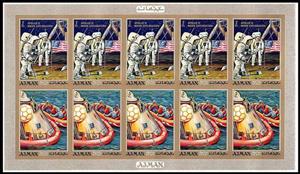Full Pane: Astronauts on the Moon - Splashdown (Ajman 1970)
Astronauts on the Moon - Splashdown (Ajman 1970)
01 July (Ajman ) within release Apollo 13 goes into circulation Full Pane Astronauts on the Moon - Splashdown face value 5*5 United Arab Emirates riyal
| Full Pane Astronauts on the Moon - Splashdown in catalogues | |
|---|---|
| Colnect codes: | Col: AJ 1970.07.00-06c |
Full Pane is square format.
Full pane not mentioned by MichelAlso in the issue Apollo 13:
- Stamp - Lovell, Swigert, Haise face value 50;
- Stamp - Start face value 75;
- Stamp - Circumlunar flight face value 80;
- Stamp - Moon landing face value 1;
- Stamp - Astronauts on the moon face value 2;
- Stamp - Splashdown face value 3;
- Stamp - Astronauts on the Moon face value 2;
- Souvenir Sheet - Astronauts on the Moon face value 3;
- Se-tenant - Astronauts on the Moon - Splashdown face value 5;
- Stamp - Circumlunar Flight face value 80;
- Souvenir Sheet - Circumlunar Flight face value 3;
- Se-tenant - Circumlunar Flight - Moon Landing face value 1.80;
- Stamp - Lovell, Swigert, Haise face value 50;
- Souvenir Sheet - Lovell, Swigert, Haise face value 3;
- Se-tenant - Lovell, Swigert, Haise - Rocket Start face value 125;
- Stamp - Moon Landing face value 1;
- Souvenir Sheet - Moon Landing face value 3;
- Souvenir Sheet - Rocket Start face value 3;
- Stamp - Splashdown face value 3;
- Souvenir Sheet - Splashdown face value 3;
- Stamp - Start face value 75;
- Se-tenant - Astronauts on the Moon - Splashdown face value 5;
- Se-tenant - Circumlunar Flight - Moon Landing face value 1.80;
- Se-tenant - Lovell, Swigert, Haise - Rocket Start face value 125;
- Full Pane - Lovell, Swigert, Haise - Rocket Start face value 5*125;
- Full Pane - Lovell, Swigert, Haise - Rocket Start face value 5*125;
- Full Pane - Astronauts on the Moon - Splashdown face value 5*5;
- Full Pane - Astronauts on the Moon - Splashdown face value 5*5;
- Full Pane - Circumlunar Flight - Moon Landing face value 5*1.80;
- Full Pane - Circumlunar Flight - Moon Landing face value 5*1.80;
- Stamp - Swigert with Apollo 13 Emblem face value 12;
- Stamp - Swigert with Apollo 13 Emblem face value 12;
Full Pane Astronauts on the Moon - Splashdown it reflects the thematic directions:
An astronaut (from the Ancient Greek ἄστρον (astron), meaning 'star', and ναύτης (nautes), meaning 'sailor') is a person trained, equipped, and deployed by a human spaceflight program to serve as a commander or crew member aboard a spacecraft. Although generally reserved for professional space travelers, the term is sometimes applied to anyone who travels into space, including scientists, politicians, journalists, and tourists
The Moon is Earth's only natural satellite. It orbits at an average distance of 384,400 km (238,900 mi), about 30 times the diameter of Earth. Tidal forces between Earth and the Moon have over time synchronized the Moon's orbital period (lunar month) with its rotation period (lunar day) at 29.5 Earth days, causing the same side of the Moon to always face Earth. The Moon's gravitational pull – and to a lesser extent, the Sun's – are the main drivers of Earth's tides.
Outer space (or simply space) is the expanse that exists beyond Earth's atmosphere and between celestial bodies. It contains ultra-low levels of particle densities, constituting a near-perfect vacuum of predominantly hydrogen and helium plasma, permeated by electromagnetic radiation, cosmic rays, neutrinos, magnetic fields and dust. The baseline temperature of outer space, as set by the background radiation from the Big Bang, is 2.7 kelvins (−270 °C; −455 °F)
A spacecraft is a vehicle that is designed to fly and operate in outer space. Spacecraft are used for a variety of purposes, including communications, Earth observation, meteorology, navigation, space colonization, planetary exploration, and transportation of humans and cargo. All spacecraft except single-stage-to-orbit vehicles cannot get into space on their own, and require a launch vehicle (carrier rocket).





